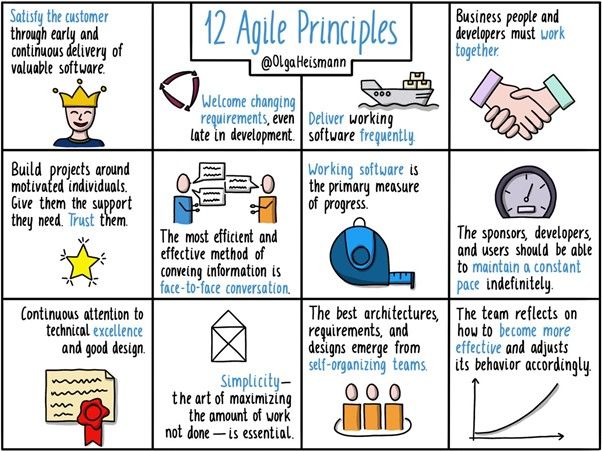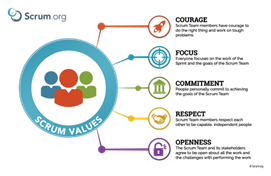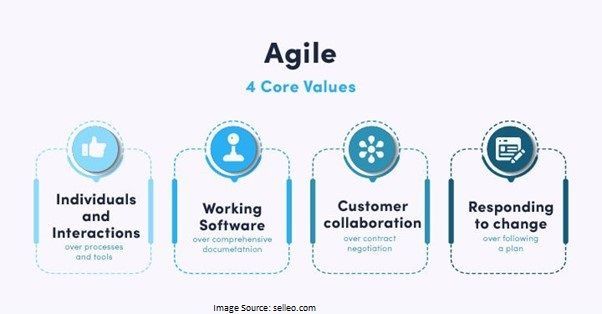What is Agile?
Agile is a process that allows a team to manage a project more efficiently by breaking it down into several stages, each of which allows for consistent collaboration with stakeholders to promote steady improvements at every stage.
What are the values of agile?
Agile was first described in the Agile Manifesto in 2000 by a group of developers who sought out a new method of writing software. The manifesto cites four values:
- Individuals and interactions over processes and tools
- Working software over comprehensive documentation
- Customer collaboration over contract negotiation
- Responding to change by following a plan
Principles of Agile?
The twelve principles of agile development include:
- Customer satisfaction through early and continuous software delivery – Customers are happier when they receive working software at regular intervals, rather than waiting extended periods of time between releases.
- Accommodate changing requirements throughout the development process – The ability to avoid delays when a requirement or feature request changes.
- Frequent delivery of working software – Scrum accommodates this principle since the team operates in software sprints or iterations that ensure regular delivery of working software.
- Collaboration between the business stakeholders and developers throughout the project – Better decisions are made when the business and technical team are aligned.
- Support, trust, and motivate the people involved – Motivated teams are more likely to deliver their best work than unhappy teams.
- Enable face-to-face interactions – Communication is more successful when development teams are co-located.
- Working software is the primary measure of progress – Delivering functional software to the customer is the ultimate factor that measures progress.
- Agile processes to support a consistent development pace – Teams establish a repeatable and maintainable speed at which they can deliver working software, and they repeat it with each release.
- Attention to technical detail and design enhances agility – The right skills and good design ensures the team can maintain the pace, constantly improve the product, and sustain change.
- Simplicity – Develop just enough to get the job done for right now.
- Self-organizing teams encourage great architectures, requirements, and designs – Skilled and motivated team members who have decision-making power, take ownership, communicate regularly with other team members, and share ideas that deliver quality products.
- Regular reflections on how to become more effective – Self-improvement, process improvement, advancing skills, and techniques help team members work more efficiently.

What is Scrum?
Scrum is a framework for effective collaborations among teams working on complex products. Scrum is a type of agile technology that consists of meetings, roles, and tools to help teams working on complex projects collaborate and better structure and manage their workload. Although it is most often used by software development teams, scrum can be beneficial to any team working toward a common goal.

The scrum framework is heuristic; it’s based on continuous learning and adjustment to fluctuating factors. It acknowledges that the team doesn’t know everything at the start of a project and will evolve through experience. Scrum is structured to help teams naturally adapt to changing conditions and user requirements, with re-prioritization built into the process and short release cycles so your team can constantly learn and improve.
What are the differences between scrum and agile?
Although scrum and agile are similar, they have some key differences:
- Scrum values rigidity, whereas agile is more flexible.
- Agile leaders play a vital role, while scrum promotes a cross-functional team that is self-functioning.
- Agile involves face-to-face interactions between cross-functional team members, while scrum involves daily stand-up meetings.
- Agile is meant to be kept simple, while scrum can be innovative and experimental.
- Scrum delivers shorter, separate projects, while agile delivers everything at the end of the process.
But, why scrum?
The scrum framework itself is simple. The rules, artefacts, events, and roles are easy to understand. Its semi-prescriptive approach actually helps remove the ambiguities in the development process, while giving sufficient space for companies to introduce their individual flavour to it. The organization of complex tasks into manageable user stories makes it ideal for difficult projects. Also, the clear demarcation of roles and planned events ensure that there is transparency and collective ownership throughout the development cycle. Quick releases keep the team motivated and the users happy as they can see progress in a short amount of time.
Agile vs. Waterfall vs. Kanban vs. Scrum
- Waterfall works best for projects completed in a linear fashion and does not allow going back to a prior phase.
- Agile focuses on adaptive, simultaneous workflows. Agile methods break projects into smaller, iterative periods.
- Kanban is primarily concerned with process improvements.
- Scrum is concerned with getting more work done faster.





